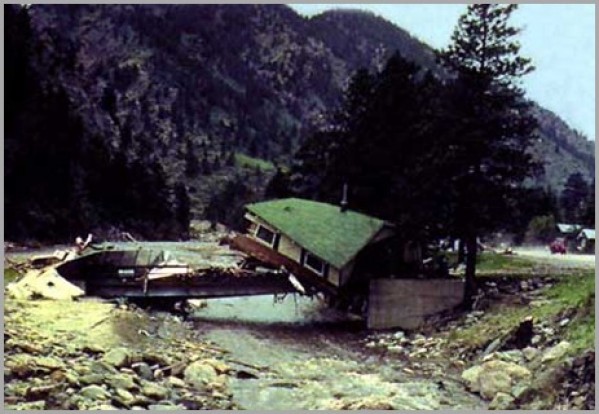The Big Thompson Canyon Flood
 Big Thompson Canyon is one of the most scenic areas of Colorado. An hour west of Denver, US-34 runs right along the Big Thompson River through much of the 25 mile long canyon.
Big Thompson Canyon is one of the most scenic areas of Colorado. An hour west of Denver, US-34 runs right along the Big Thompson River through much of the 25 mile long canyon.
The weekend of July 31-August 1, 1976 was the Centennial Celebration of Colorado Statehood. Thousands of hikers and campers crowded into the Canyon to enjoy a busy summer weekend of recreation. There probably were never more people in the Canyon in the 20th century than there were that Saturday evening, probably around 2500 or more.
On that fateful afternoon, easterly surface winds were blowing warm, humid air up the Front Range of the Rockies. As the unstable air rose, it condensed into a huge thunderstorm over Estes Park. Winds aloft were very light and the storm remained stationary over the same area for hours.
Beginning at 8:30 p.m., as much as 12 inches or rain was dumped directly on the canyon by the thunderstorm. Eight inches fell in just two hours at Glen Haven and Glen Comfort. Four inches of rain fell in four hours over a wide areas. The rock walls of the steep canyon did not soak up any of the rainfall and the river quickly rose.
A 20 foot wall of water poured down the canyon, taking everything in its path, including unwitting campers and residents. A total of 144 people were killed in the flood and the bodies of five people have never been found. Many miles of US-34 were wiped out by the flood. It took over a year to rebuild the highway. Damage totaled over $35 million.
Before the flood event, the streamflow on the river was a meager 127 cubic feet per second. At the peak of the flood, it was an unthinkable 31,200 cubic fet per second.
Before 1976, there was little comprehension of the potential of a severe flood there. Visitors to Front Range canyons now find signs warning them to climb to safety in case of flash floods.
The 1970s were the worst decade for flash floods in U.S. history. There was the Buffalo Creek disaster in West Virginia in February 1972 that claimed 125 lives, followed by the Black Hills flood in Rapid City in June 1972 that killed 237 and the 1977 Johnstown flood (76 fatalities).
Flash floods killed an average of 127 people each year in the United States between 1972-2001. Improvements in forecasting and warning have ben effective in reducing the big death tolls from individual disasters. No single flash flood has killed morethan 100 people since 1980. But an average of over 100 Americans still lose their lives each year in flash flooding.
A reminder to turn around, don’t drown
Category: Met 101/Weather History


















